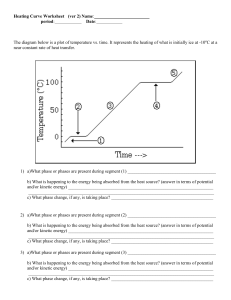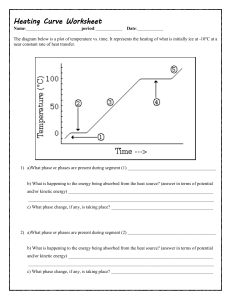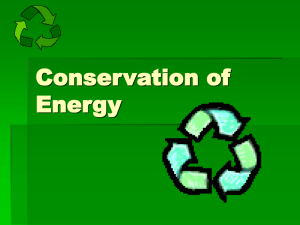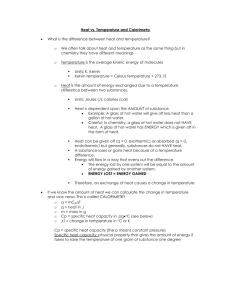Heating Curve Worksheet
advertisement
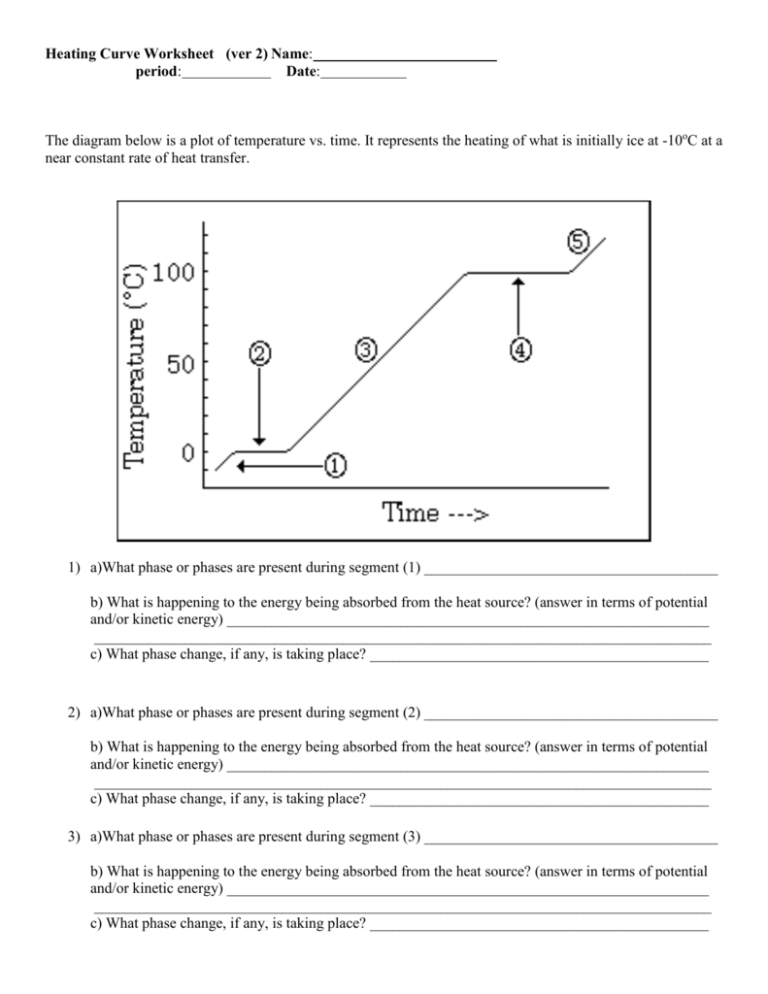
Heating Curve Worksheet (ver 2) Name: period: Date: The diagram below is a plot of temperature vs. time. It represents the heating of what is initially ice at -10oC at a near constant rate of heat transfer. 1) a)What phase or phases are present during segment (1) _______________________________________ b) What is happening to the energy being absorbed from the heat source? (answer in terms of potential and/or kinetic energy) ________________________________________________________________ __________________________________________________________________________________ c) What phase change, if any, is taking place? _____________________________________________ 2) a)What phase or phases are present during segment (2) _______________________________________ b) What is happening to the energy being absorbed from the heat source? (answer in terms of potential and/or kinetic energy) ________________________________________________________________ __________________________________________________________________________________ c) What phase change, if any, is taking place? _____________________________________________ 3) a)What phase or phases are present during segment (3) _______________________________________ b) What is happening to the energy being absorbed from the heat source? (answer in terms of potential and/or kinetic energy) ________________________________________________________________ __________________________________________________________________________________ c) What phase change, if any, is taking place? _____________________________________________ 4) a)What phase or phases are present during segment (4) _______________________________________ b) What is happening to the energy being absorbed from the heat source? (answer in terms of potential and/or kinetic energy) ________________________________________________________________ __________________________________________________________________________________ c) What phase change, if any, is taking place? _____________________________________________ 5) a)What phase or phases are present during segment (5) _______________________________________ b) What is happening to the energy being absorbed from the heat source? (answer in terms of potential and/or kinetic energy) ________________________________________________________________ __________________________________________________________________________________ c) What phase change, if any, is taking place? _____________________________________________ 6) What is the melting point of this substance? 7) At what temperature would this sample finish boiling? 8) a. b. c. d. When this substance is melting, the temperature of the ice-water mixture remains constant because: Heat is not being absorbed The ice is colder that the water Heat energy is being converted to potential energy Heat energy is being converted to kinetic energy 9) When a given quantity of water is heated at a constant rate, the phase change from liquid to gas takes longer than the phase change from solid to liquid because a. The heat of vaporization is greater than the heat of fusion b. The heat of fusion is greater than the heat of vaporization c. The average kinetic energy of the molecules is greater in steam than in water d. Ice absorbs energy more rapidly than water does The heat of fusion for water (Hf) is 80 calories/gram and the heat of vaporization (Hv) for water is 540 calories/gram. 10) a) How much energy would be required to melt 500 grams of ice at 0oC to water at 0oC? b) How much energy would be required to convert 2 moles of water at 100oC to water vapor at 100oC? Heating Curve Worksheet (ver 2) Name: ANSWERS 1) a)What phase or phases are present during segment (1) _________SOLID_________________________ b) What is happening to the energy being absorbed from the heat source? (answer in terms of potential and/or kinetic energy) _____The K.E. of vibration is increasing________________ __________________________________________________________________________________ c) What phase change, if any, is taking place? _____NONE (perhaps sublimation)_______ 2) a)What phase or phases are present during segment (2) _____SOLID & LIQUID__________________ b) What is happening to the energy being absorbed from the heat source? (answer in terms of potential and/or kinetic energy) ______The energy is causing the position of the atoms to change (P.E. is increasing) there is a phase change_________________________________________________ c) What phase change, if any, is taking place? __________MELTING___________________________ 3) a)What phase or phases are present during segment (3) ________LIQUID________________________ b) What is happening to the energy being absorbed from the heat source? (answer in terms of potential and/or kinetic energy) _______The K.E. is increasing (the particles move faster; temperature increases__________________________________________________________________________ c) What phase change, if any, is taking place? _______NONE (perhaps some evaporation)________ 4) a)What phase or phases are present during segment (4) ________LIQUID & GAS_________________ b) What is happening to the energy being absorbed from the heat source? (answer in terms of potential and/or kinetic energy) _______The P.E. increases as the particles move Far, far apart_____________ __________________________________________________________________________________ c) What phase change, if any, is taking place? _____Boiling________________________________________ 5) a)What phase or phases are present during segment (5) ____________GAS______________________ b) What is happening to the energy being absorbed from the heat source? (answer in terms of potential and/or kinetic energy) _______The K.E. of the gas is increasing____________________ __________________________________________________________________________________ c) What phase change, if any, is taking place? _________None______________________________ 0oC 6) What is the melting point of this substance? 7) At what temperature would this sample finish boiling? 8) a. b. c. d. When this substance is melting, the temperature of the ice-water mixture remains constant because: Heat is not being absorbed The ice is colder that the water Heat energy is being converted to potential energy Heat energy is being converted to kinetic energy 100oC 9) When a given quantity of water is heated at a constant rate, the phase change from liquid to gas takes longer than the phase change from solid to liquid because a. The heat of vaporization is greater than the heat of fusion b. The heat of fusion is greater than the heat of vaporization c. The average kinetic energy of the molecules is greater in steam than in water d. Ice absorbs energy more rapidly than water does The heat of fusion for water (Hf) is 80 calories/gram and the heat of vaporization (Hv) for water is 540 calories/gram. 10) a) How much energy would be required to melt 500 grams of ice at 0oC to water at 0oC? 500g ( 80 calories/g) = 40 000 calories b) How much energy would be required to convert 2 moles of water at 100oC to water vapor at 100oC? 2 mol H2O (18 g H2O / mol H2O) (540 calories/g H2O) = 19440 calories or 19.44 kcal.
